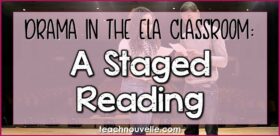
Drama in the Classroom: Tips & Activities
Using theatre in Secondary ELA is a great way to build classroom community, increase public speaking skills, and get students to understand complex texts. Here are some ideas for how to introduce drama in the classroom, from quick, 5-minute games to a class play. Improv Games build public speaking skills In every English class I’ve ever taught, I’ve used improv games to help students build public speaking skills. When I taught ESL in Germany, my students LOVED telling wacky stories in games like “Story, Story, Die!” Here are two sets of improv ideas you can use in any class! Improv games are a great way to spend an extra five minutes or what’s left after a fire drill, so you should definitely have a few in your pocket. Halloween Themed Drama Games Drama in the






